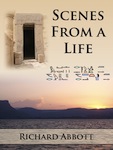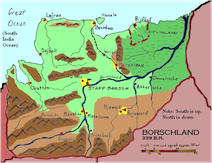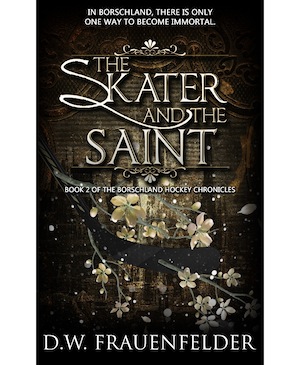How are stories planned and organised? More interestingly, how have they been arranged in different parts of the world and times in history? Today I want to talk about a common middle eastern pattern, “ring structure”. Nowadays, the pattern most commonly talked about is called “three act structure”. Some people use this title just as a convenient piece of shorthand, but others try to argue that there is something fundamental about it, even to the extent of suggesting that there is some basis in human brain chemistry that favours it.
Three act structure is pretty much stock in trade for Hollywood films and so has big money behind it. Basically, 1) the plot presents a problem to the main character. A first attempt to solve it fails. So 2) a more elaborate attempt to solve it is set up and also fails, this time in such a way that things look hopeless. Then 3) a final sacrificial attempt is made and it is resolved.
But is there really anything profound in this pattern? I want here to distinguish between film plots and book plots. These are different media and so might quite reasonably have different forms – why should a film follow a book storyline any more than if the key plot ideas were turned into a musical, or a poem, or a piece of art? However, typically, people who know a book well routinely end up disappointed with a film adaptation.
Now, despite some of the things which have been said about it, there is no real reason to suppose that having three acts mirrors anything deep about the human soul. Many pieces of literature have used entirely different patterns, and I want to focus on a few of these over an intermittent series of blog articles.
So for today, I want to look at ring structure – the key moment or event is placed in the middle of the work. It is, quite literally, pivotal, or centrally important to the plot. Bailey, back in the late 1990s, said of this pattern “The primary language of the picture is placed in the climactic center. Around that center is a series of interpretive semantic “envelopes”, which provide direction to the reader’s imagination“. On similar lines, Radday said “Chiastic structure… is more than an artificial or artistic device… it is rather, and most remarkably so, a key to meaning“. In the ancient near eastern world this pattern was common, and it has survived to some degree through to the present.
 The typical pattern is to open with a state of stability and peace, which is then disrupted in some way – perhaps by a natural crisis, or by wickedly motivated individuals. The disruption may be presented from several different points of view, depending on the length of the work. The pivotal event is at the centre to resolve the crisis – in some texts it might be a battle, for example, but in others it will be a celebration of a god, nation or individual. Merenptah’s Israel Stele has “A great wonder has occurred for Egypt“. The Hebrew “Song of the Sea” (Exodus 15, first half) has “Who like you among the gods? Yahweh!“. After the central affirmation the situation ‘unwinds’, commonly in symmetric ways to the opening layers, and the setting is restored to peace and stability.
The typical pattern is to open with a state of stability and peace, which is then disrupted in some way – perhaps by a natural crisis, or by wickedly motivated individuals. The disruption may be presented from several different points of view, depending on the length of the work. The pivotal event is at the centre to resolve the crisis – in some texts it might be a battle, for example, but in others it will be a celebration of a god, nation or individual. Merenptah’s Israel Stele has “A great wonder has occurred for Egypt“. The Hebrew “Song of the Sea” (Exodus 15, first half) has “Who like you among the gods? Yahweh!“. After the central affirmation the situation ‘unwinds’, commonly in symmetric ways to the opening layers, and the setting is restored to peace and stability.
A few years ago now I made a study of this in the PhD thesis Triumphal Accounts in Hebrew and Egyptian. In this I showed how some key texts in New Kingdom Egypt and the oldest strands of the Hebrew Bible use ring structure, and its stricter cousin chiasmus, to provide the framework for their narrative. But use of the pattern is not restricted to the ancient world, and it was in use in rural middle eastern contexts within living memory. Some people have argued that it reflects a difference in world-view. Three-act, credibly, lends itself to a conquering, pioneering mentality in which obstacles are only there to be surmounted in pursuit of a supreme goal. Ring structure lends itself to a view which values cohesion around a crucial centre. Perhaps it is not surprising that Hollywood likes one and not the other!
Some modern authors have experimented with this pattern, such as Hemingway in The Sun also Rises. There are even elements of the ring structure in the typical Star Trek (original series) plot, when Kirk, Bones and Spock collect on the bridge on a wind-down return-to-normality session after saving the world again. On a more domestic scale, I built In a Milk and Honeyed Land according to the structure: readers can entertain themselves working out the key events which I have set as the pivot, and how concentric patterns are set up during the book as a whole.
With influences from world literature increasingly impacting on British and European fiction (from what I have seen, America lags behind a little here), it is to be hoped that ring patterns will come back into larger scale use. They provide an interesting and creative variation of plot structure, and potentially say something important about a world view.


 However, the book as a whole did not click with me as much as the first one. For one thing there are essentially no female characters explored sympathetically or in depth. This would be fair enough for the shipboard experience, but in Britannia’s Wolf, Antoine successfully found ways to bring female balance into the narrative.
However, the book as a whole did not click with me as much as the first one. For one thing there are essentially no female characters explored sympathetically or in depth. This would be fair enough for the shipboard experience, but in Britannia’s Wolf, Antoine successfully found ways to bring female balance into the narrative. One of my great joys of reading this book was simply the pleasure of knowing the terrain Elditha and her various companions move across – at least, the modern version of it. The river trip along the Thames near Oxford, the approach to the Severn valley, the view of the estuary at Exeter – all were vivid episodes enhanced by my own experience of them. They are, I think, well enough described that someone who does not know the land would still appreciate them.
One of my great joys of reading this book was simply the pleasure of knowing the terrain Elditha and her various companions move across – at least, the modern version of it. The river trip along the Thames near Oxford, the approach to the Severn valley, the view of the estuary at Exeter – all were vivid episodes enhanced by my own experience of them. They are, I think, well enough described that someone who does not know the land would still appreciate them.
 The typical pattern is to open with a state of stability and peace, which is then disrupted in some way – perhaps by a natural crisis, or by wickedly motivated individuals. The disruption may be presented from several different points of view, depending on the length of the work. The pivotal event is at the centre to resolve the crisis – in some texts it might be a battle, for example, but in others it will be a celebration of a god, nation or individual. Merenptah’s Israel Stele has “A great wonder has occurred for Egypt“. The Hebrew “Song of the Sea” (Exodus 15, first half) has “Who like you among the gods? Yahweh!“. After the central affirmation the situation ‘unwinds’, commonly in symmetric ways to the opening layers, and the setting is restored to peace and stability.
The typical pattern is to open with a state of stability and peace, which is then disrupted in some way – perhaps by a natural crisis, or by wickedly motivated individuals. The disruption may be presented from several different points of view, depending on the length of the work. The pivotal event is at the centre to resolve the crisis – in some texts it might be a battle, for example, but in others it will be a celebration of a god, nation or individual. Merenptah’s Israel Stele has “A great wonder has occurred for Egypt“. The Hebrew “Song of the Sea” (Exodus 15, first half) has “Who like you among the gods? Yahweh!“. After the central affirmation the situation ‘unwinds’, commonly in symmetric ways to the opening layers, and the setting is restored to peace and stability. 
 The background is the same – the country of Borschland is part of a continent in the southern hemisphere of our world. This continent is sometimes in phase with us (and so accessible) and sometimes out of phase (and so in splendid isolation). The stories revolve around the occasional crossover characters who go from here to there and choose to remain. For complex reasons, the whole continent is gripped with a passionate enthusiasm for ice skating in general and ice hockey in particular. You don’t need to have read the first novel to enjoy this book, since they form a loosely connected series rather than parts of a trilogy or some such.
The background is the same – the country of Borschland is part of a continent in the southern hemisphere of our world. This continent is sometimes in phase with us (and so accessible) and sometimes out of phase (and so in splendid isolation). The stories revolve around the occasional crossover characters who go from here to there and choose to remain. For complex reasons, the whole continent is gripped with a passionate enthusiasm for ice skating in general and ice hockey in particular. You don’t need to have read the first novel to enjoy this book, since they form a loosely connected series rather than parts of a trilogy or some such.